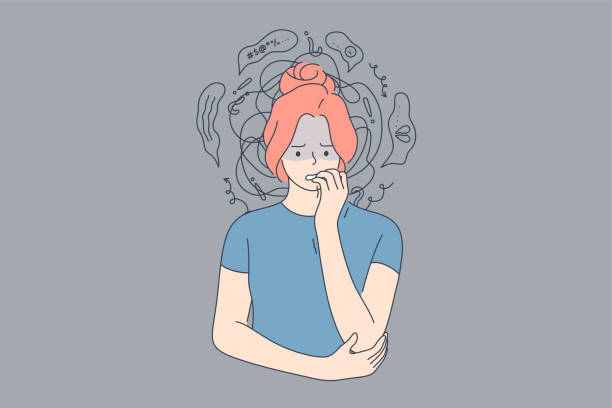How To Describe A Panic Attack In Writing (10 significant steps)
Describing a panic attack in writing is akin to navigating a tumultuous sea of emotions, thoughts, and physical sensations.
It is an endeavor that calls for a delicate balance between empathy and precision, as the writer strives to convey the complex and often overwhelming experience of panic with authenticity.
Through carefully chosen words, vivid imagery, and nuanced descriptions, the writer seeks to bring the reader into the heart of the storm, allowing them to not only witness but also deeply feel the disorienting torrent of fear, anxiety, and desperation.
To describe a panic attack is to embark on a literary journey that transcends the boundaries of language, inviting readers to step into the shoes of those who have weathered this internal tempest, offering insight into a realm often hidden from view.

How To Describe A Panic Attack In Writing
Describing a panic attack in writing involves a step-by-step process that aims to capture the multifaceted nature of the experience. Here’s how to do it:
Research and Understanding:
Begin by researching panic attacks to understand their physiological, psychological, and emotional aspects. This will provide a foundation for accurate portrayal.
Choose a Perspective:
Decide whether to describe the panic attack from a first-person or third-person perspective. Both choices offer unique insights into the internal struggle.
Setting the Scene:
Create a vivid atmosphere by describing the surroundings using sensory details. Consider time, place, weather, and any elements that contribute to the mood.
Internal Sensations:
Detail the physical sensations that accompany panic attacks, such as heart palpitations, shortness of breath, trembling, and sweating. Use descriptive language to convey the intensity.
Cognitive Chaos:
Depict the racing thoughts, confusion, and mental turmoil that often accompany panic attacks. Show the struggle between rationality and irrationality.
Emotional Turmoil:
Express the overwhelming fear, dread, and impending doom that characterize panic attacks. Use metaphors and similes to intensify emotions.
Inner Dialogue:
Capture the inner monologue, self-doubt, and negative self-talk that contribute to the distress. This gives insight into the protagonist’s internal conflict.
Physical Sensations:
Detail the physical symptoms that the person experiencing the panic attack might feel. This can include rapid heartbeat, shortness of breath, sweating, trembling, dizziness, and chest pain.
Emotional State:
Depict the intense fear and anxiety that the person is feeling. Use descriptive language to convey the overwhelming sense of dread, the feeling of losing control, and the fear of imminent danger.
Triggers:
Discuss common triggers, such as stressful situations, phobias, social anxiety, and trauma. Emphasize that panic attacks can occur unexpectedly as well, causing further distress.

Setting the Stage:
Imagine stepping into a world where every heartbeat echoes like a drum, where even the air you breathe seems charged with an electric tension.
The sun hangs low in the sky, casting long shadows that dance upon the ground. The air is heavy with an impending storm, and a distant rumble of thunder sends shivers down your spine.
It’s as if the atmosphere itself is holding its breath, waiting for something unknown yet inevitable. This is the moment before the storm breaks, the calm before chaos, and you’re standing right at the heart of it all, senses alive and anticipation building.
The Descent into Panic:
As sanity begins to crumble, the body betrays its calm facade.
The heart becomes a relentless drummer, its beats racing like wild hooves against the cage of ribs. Breaths turn shallow, a desperate grasp for the elusive oxygen that seems to have abandoned its duty.
Tremors seize hold, vibrating from fingertips to the core, while a cold sweat descends like a frosty curtain. In the mind’s labyrinth, thoughts collide like runaway trains, each carriage carrying a cargo of fear, doubt, and confusion.
It’s a symphony of chaos, a ballet of dread, as panic’s inexorable gravity pulls everything into its suffocating vortex.
Shortness of breath and difficulty breathing
The air, once a familiar friend, now turns traitor, slipping through tightened passages like sand through clenched fists.
Lungs that once expanded with ease now labor as if burdened by invisible chains. Each inhale is a battle fought against an unseen force, a struggle that leaves the chest constricted, aching for relief.
The very act of breathing, once an autonomic rhythm, now demands conscious effort, a desperate grasp for life-giving oxygen.
As the walls of the world seem to close in, the body’s plea for air echoes in the mind, a primal reminder of the fragile balance between existence and the abyss.
Confusion and disorientation
Thoughts, once orderly sentinels, now revolt into a riotous frenzy, a cacophony of discordant voices clashing in the mind’s arena.
The familiar pathways of reason are obscured, replaced by a labyrinth of tangled threads that lead nowhere. Concepts that once held clarity crumble like ancient parchment, leaving a residue of bewilderment.
Time itself becomes a slippery eel, sliding through grasping fingers, its true nature distorted by the mind’s disarray.
Reality splinters into fractured pieces, and the world takes on a surreal hue, as if painted by a mad artist. In the midst of this cognitive tempest, the self becomes a sailor lost in a fog, desperately seeking the lighthouse of coherence amid the storm of confusion.

Overwhelming sense of dread:
Dread, that ancient and primal specter, rises like a tidal wave, swallowing every other emotion in its path. It’s a weight that presses down upon the soul, a suffocating blanket that smothers any glimmer of hope.
A dark cloud, heavy with foreboding, casts its shadow across every thought, every heartbeat, reminding the heart that its steady rhythm is but a whisper against the thunderous roar of impending disaster.
It’s a sensation that defies reason, transcending the boundaries of logic and lodging itself deep within the marrow. Every nerve is a live wire, pulsating with a fear that’s as primal as it is inexplicable.
The overwhelming sense of dread wraps its fingers around the psyche, tightening its grip with each passing second, until the world itself seems poised on the precipice of a nameless abyss.
Feeling of detachment from reality:
Reality becomes an elusive phantom, slipping through grasp like sand through loosely clenched fingers. The world, once solid and dependable, now takes on the quality of a dream, a mirage dancing at the edges of perception.
The senses, dulled and distant, convey a distorted version of the truth, like a funhouse mirror reflecting a warped reflection.
It’s as if a veil has been drawn between the self and the world, leaving a disconcerting hollowness in its wake. Actions and events unfold as if through a thick fog, leaving the mind suspended in a state of uncertain suspension.
In this realm of detachment, the self is both observer and observed, a ghostly presence haunting the fringes of reality, yearning for reconnection but held back by the intangible threads of disconnection.

Describing the Internal Struggle:
Within the echoing chambers of the mind, a battle rages with the ferocity of a storm at sea. Reason and panic lock horns in a clash of titans, their conflict a symphony of discordant notes that reverberate through every thought.
The self stands at the crossroads of this turmoil, a hesitant traveler torn between the well-trodden path of logic and the uncharted wilderness of fear.
The inner dialogue is a tempest of contradictions, with self-doubt and self-assurance waging a constant war, each word a weapon, each thought a battlefield.
It’s a struggle that’s both intimate and universal, a portrayal of the human spirit’s tenacity in the face of its own vulnerabilities.
Self-doubt and negative self-talk:
Amid the chaotic fray of emotions, self-doubt emerges as a relentless adversary, its whispers more piercing than any battle cry.
Negative self-talk, that venomous serpent, weaves its way through the labyrinth of thoughts, poisoning the well of self-assurance.
Every decision is tainted by its insidious influence, every action second-guessed, every accomplishment belittled. It’s a constant barrage of demeaning commentary, a barrage that erodes confidence like waves against a fragile shoreline.
The mind becomes a battleground where the fiercest opponent is one’s own reflection, and the wounds inflicted by self-doubt cut deeper than any external adversary could.
Inner conflict between reason and panic:
As the storm of panic gathers momentum, reason stands firm like a lighthouse, casting its steady beam of logic against the tumultuous waves.
Yet, panic is a wild tempest that thrashes against the shores of reason, seeking to obliterate its light. The clash between the two is a tumultuous dance, a relentless tug-of-war that strains the very fabric of the psyche.
Reason tries to soothe the raging waters with facts and analysis, while panic rides the currents of irrationality, threatening to capsize the fragile vessel of composure.
It’s a battle of intellect against instinct, a duel that leaves the mind’s landscape scarred with the marks of internal warfare.
Flashbacks or intrusive memories:
Amid the chaos of the present, the past emerges like a specter, haunting the recesses of the mind with a vengeance.
Flashbacks and intrusive memories are the ghosts of experiences once lived, now resurrected to torment the present moment. They crash upon the consciousness like tidal waves, their vividness rendering them impossible to ignore.
In the midst of panic’s frenzy, these unwelcome apparitions pull the mind into a whirlpool of recollections, each one carrying the weight of its original emotion.
The boundary between then and now blurs, as the present is consumed by the flames of the past, intensifying the internal tempest with every remembered detail.

External Observations:
As panic’s grip tightens, the world becomes a surreal tableau, each detail etched with an almost otherworldly clarity.
The surroundings, once mere backdrops, transform into hyper-realistic dioramas, their edges sharpened as if seen through a magnifying glass. Yet, as the senses become acutely attuned, a disconcerting disconnection takes hold.
Faces, once familiar constellations, morph into enigmatic mosaics of expression, their meaning indecipherable in the labyrinth of panic.
It’s a disorienting dance of heightened awareness and disengagement, a paradoxical state where everything is seen and nothing is truly comprehended.
In this maelstrom, the world itself seems to flicker at the edges, like a glitch in reality’s matrix, as the external observations mirror the internal tumult.
Disconnection from the environment:
Amid the frenzy of panic, the environment undergoes a profound metamorphosis, as if seen through a fractured lens.
What was once familiar becomes alien, a landscape inhabited by phantoms of recognition. The world’s contours blur and colors fade, replaced by a monotone haze that obscures the boundaries between objects.
Even the most mundane sounds—footsteps, whispers, the rustling of leaves—take on a discordant timbre, their origins shrouded in uncertainty.
It’s a realm of detachment, where the senses are both heightened and numbed, where the environment is a shifting mirage that slips through fingers like sand. In this disconnection, the self becomes adrift, a lone wanderer in a landscape that seems to have forgotten its coordinates.
Climax and Resolution:
In the crescendo of panic’s symphony, there comes a point of no return—the climax. It’s as if the world holds its breath, teetering on the precipice of an abyss.
Heartbeats thunder like a war drum, thoughts are a cacophony of chaos, and every fiber of being is consumed by the tempest. But just as the storm reaches its zenith, a flicker of clarity emerges.
The resolution, a distant beacon, beckons with a promise of calm. Slowly, like a mist lifting, the tempest recedes, replaced by a fragile serenity.
Heartbeats soften their frantic pace, thoughts coalesce into coherence, and the soul emerges from the abyss, battered but unbroken. It’s a moment of redemption, a reminder of the indomitable strength within.
In the aftermath of the storm, the resolution becomes a testament to the human spirit’s capacity to weather even the most ferocious of emotional hurricanes.
Peaking of Panic Symptoms:
In the zenith of the storm, panic’s grip becomes an iron vise, squeezing every fiber of one’s being with merciless intensity.
Heartbeats echo like the thunder of war drums, reverberating through the chest as if threatening to burst free. Breath becomes a frantic chase, a desperate grasp for air that feels perpetually out of reach.
The body trembles as if seized by invisible hands, and a cold sweat blankets the skin like a second skin of dread.
Thoughts are a whirlwind of chaos, a symphony of discordant notes that drown reason in their cacophony. It’s a moment of culmination, where the body’s fight-or-flight response reaches its zenith, and the world narrows to a tunnel of panic.
The peaking of panic symptoms is a tumultuous crescendo, a storm within that mirrors the chaos without.
Culmination of physical and emotional distress:
In the crucible of panic, physical and emotional distress converge like two rivers merging into a raging torrent.
The body’s anguish becomes an all-encompassing tempest, a symphony of heartbeats that pound against the chest’s prison, a breath that’s a jagged climb up a mountain of air.
But it’s not just the body that’s wracked by distress; emotions become an orchestra of turmoil, each note a sharp stab of fear, each chord a resonance of dread.
It’s as if every nerve ending is a live wire, sparking with the intensity of emotion, amplifying the body’s tumultuous symphony.
The culmination of physical and emotional distress is a tsunami that sweeps away all semblance of calm, leaving behind a landscape scarred by the ravages of the internal storm.
Residual anxiety and exhaustion:
As the storm of panic subsides, it leaves in its wake an aftermath of residual anxiety and bone-deep exhaustion.
The mind, once a tempest of chaotic thoughts, now settles into a state of uneasy calm, but the tension lingers like the fading echoes of thunder.
Anxieties, once at a fever pitch, recede into the background, yet their presence is felt like a lingering shadow. The body, drained from the physical onslaught, becomes a vessel of weariness, each limb heavy as if carved from stone.
It’s a fragile equilibrium between the lingering unease and the relief of surviving the tempest.
The residual anxiety and exhaustion are reminders of the battle waged, scars etched into the mind and body, testaments to the endurance of the human spirit.

Language and Stylistic Devices:
Language becomes a masterful tapestry woven from the threads of emotion and experience, employing stylistic devices that paint the canvas of panic with vivid hues.
Metaphors and similes, like brushstrokes of insight, breathe life into the intangible, allowing readers to taste the bitterness of fear and feel the weight of uncertainty.
Sensory imagery becomes a portal, transporting them into the very heart of the storm—each sight, sound, touch, smell, and taste a portal to empathy.
Symbolism takes root, infusing each detail with layers of meaning, and motifs resurface like leitmotifs in a haunting symphony.
The language becomes an instrument, conducting emotions in a symphony of words, manipulating pacing, rhythm, and tone to create an immersive experience that resonates long after the words are read.
Employing symbols to convey emotional layers:
Symbols become the hidden keys to unlock the depths of emotion, transcending the confines of language to reveal the unspoken.
They’re the brushstrokes on the canvas of the narrative, each stroke carrying a weight of meaning beyond its physical presence.
A wilting flower might symbolize the fragility of hope, while a distant storm cloud could mirror the protagonist’s internal turmoil.
A flickering candle becomes a metaphor for resilience in the face of darkness, and an abandoned, broken mirror may reflect shattered self-perception.
These symbols are the silent messengers of the heart, carrying emotional layers that words alone might fail to capture. They infuse the story with a richness that resonates on a subliminal level, inviting readers to decipher the hidden language of the soul.
Frequently Asked Questions (FAQ) about How to Describe A Panic Attack In Writing:
What’s the best perspective to describe a panic attack from?
The perspective you choose depends on your narrative goals. First-person offers an intimate immersion into the experience, while third-person can provide a more objective overview. Decide which perspective aligns better with your storytelling.
How can I make the description emotionally resonant without overwhelming the reader?
Utilize sensory details, metaphors, and similes to convey emotions without drowning the reader in excessive intensity. Balancing vivid descriptions with moments of respite can create a more authentic and reader-friendly portrayal.
What’s the importance of accurately portraying physical sensations?
Accurately describing physical symptoms—such as racing heart, difficulty breathing, and trembling—adds realism and helps readers empathize with the experience. These sensations are central to understanding the panic attack.
Is it essential to include external observations in the description?
Yes, external observations provide context and contrast to the internal turmoil. Describing how the environment changes during a panic attack can enhance the reader’s understanding of the impact on the individual.
How can I effectively convey the internal struggle during a panic attack?
Show the battle between rational thinking and irrational fears through internal dialogues and conflicting thoughts. Highlight the tug-of-war between reason and panic as a central aspect of the experience.
Should I focus more on emotions or physical sensations?
Balance is key. Emphasize both emotional and physical aspects to create a comprehensive picture. The emotions give depth to the experience, while physical sensations provide tangible details.
Can I use symbolism to enhance the description?
Absolutely. Symbolism can add layers of meaning to your portrayal. Utilize symbols that resonate with the themes of panic, fear, and vulnerability to enrich the narrative.
What’s the role of language and stylistic devices in describing panic attacks?
Stylistic devices like sensory imagery, metaphors, and similes bring the experience to life, making it more relatable and engaging. These devices can evoke emotions and immerse readers in the narrative.
How can I end the description effectively?
Consider ending with a reflection on the aftermath, conveying the lingering impact of the panic attack—residual anxiety, exhaustion, and the journey toward recovery.
How can I ensure my portrayal is accurate and respectful to those who experience panic attacks?
Conduct thorough research, read personal accounts, and consult mental health resources to gain insight. Focus on empathy and understanding, striving to capture the essence of the experience while avoiding sensationalization.
Should I share my portrayal with individuals who have experienced panic attacks?
Sharing your portrayal with those who have personal experience can provide valuable feedback and ensure the accuracy of your description. Their insights can help you refine your portrayal further.
Is it okay to fictionalize elements while describing panic attacks?
Fictionalization is acceptable as long as it doesn’t compromise the authenticity and empathy of the portrayal. Ensure that the core elements accurately reflect the experience while allowing creative freedom within those boundaries.
Conclusion:
In the art of describing a panic attack in writing, one embarks on a profound journey—one that demands both empathy and precision.
Through the meticulous selection of words, the deft application of literary techniques, and a deep understanding of the emotional and physiological layers, writers can unravel the intricacies of this often overwhelming experience.
By immersing readers in the tempest of emotions, thoughts, and sensations, a vivid and authentic portrayal emerges, bridging the gap between those who have experienced panic attacks and those who seek to understand them.
As writers navigate the labyrinthine landscape of panic, they wield the power to shed light on the darkness, to foster empathy, and to offer solace to both the afflicted and the curious.
The description of a panic attack, at its core, is an act of compassion—an endeavor to translate the language of the heart’s turmoil into words that resonate, heal, and ultimately unite.






